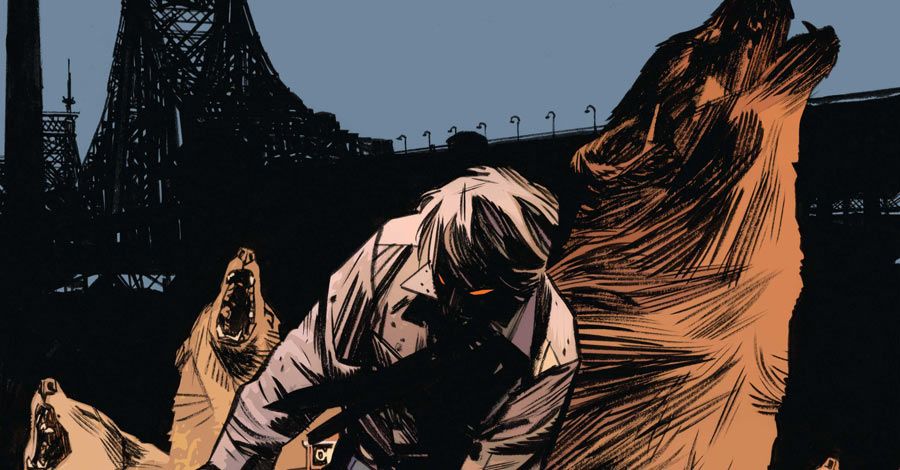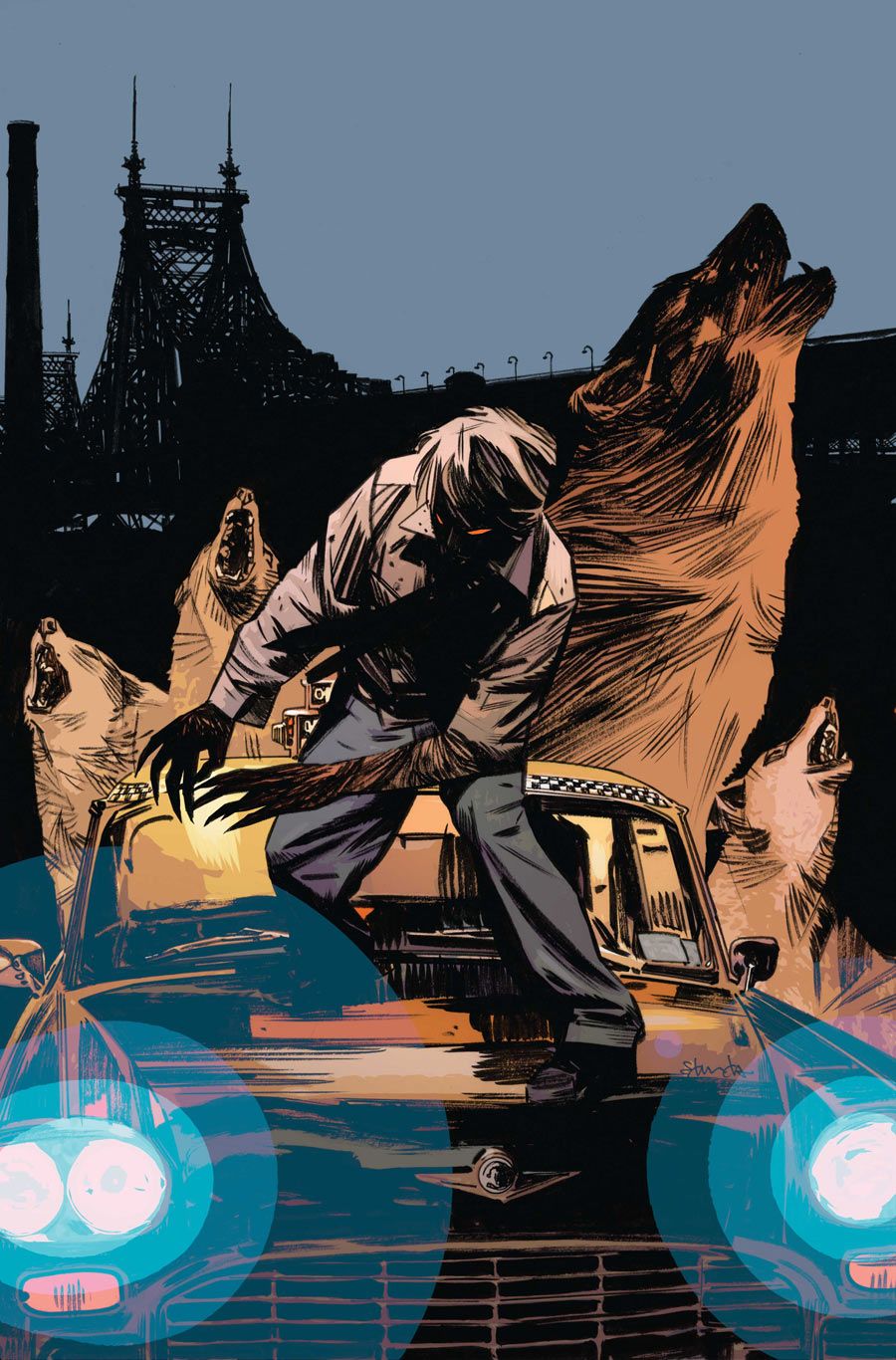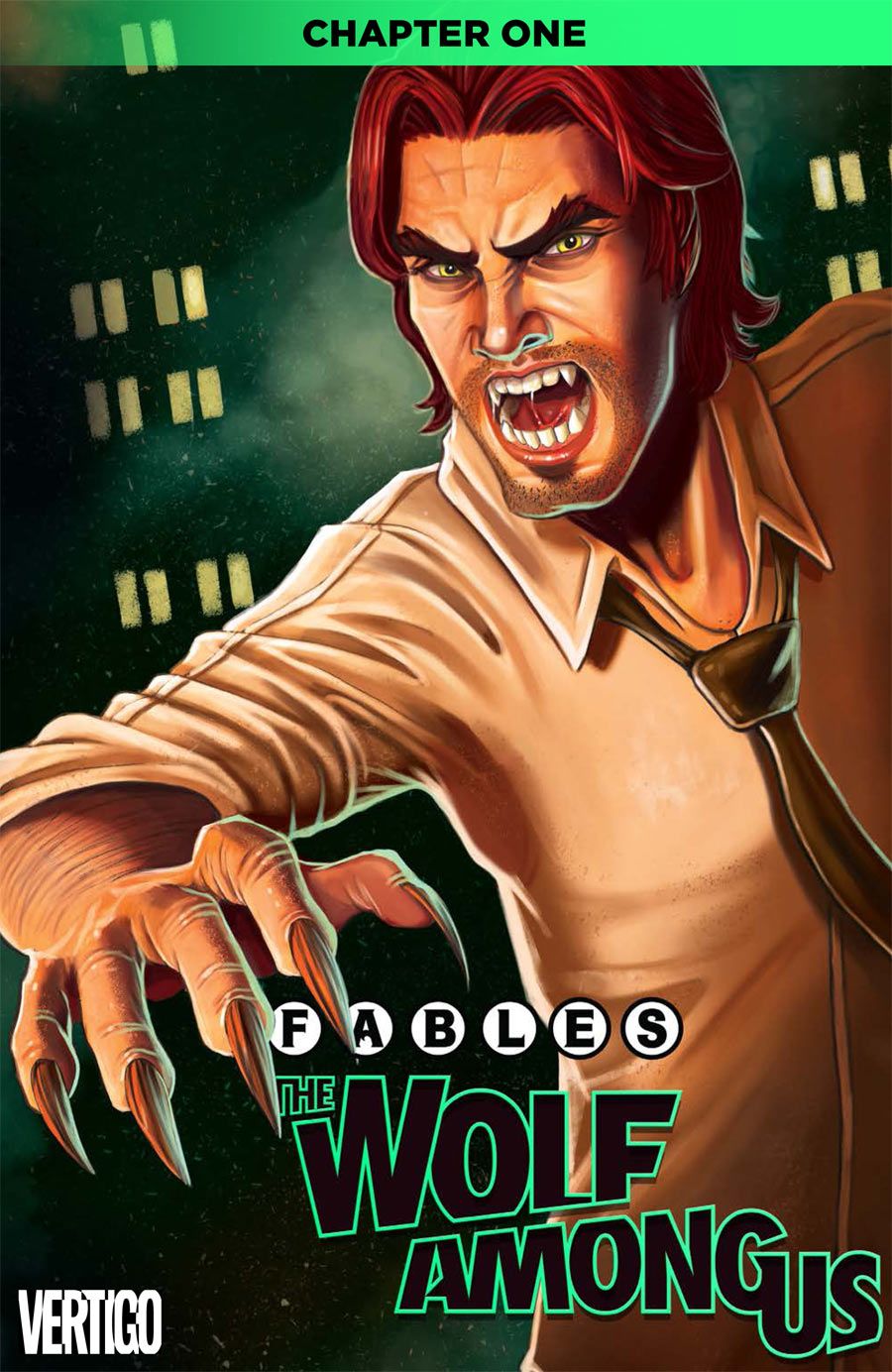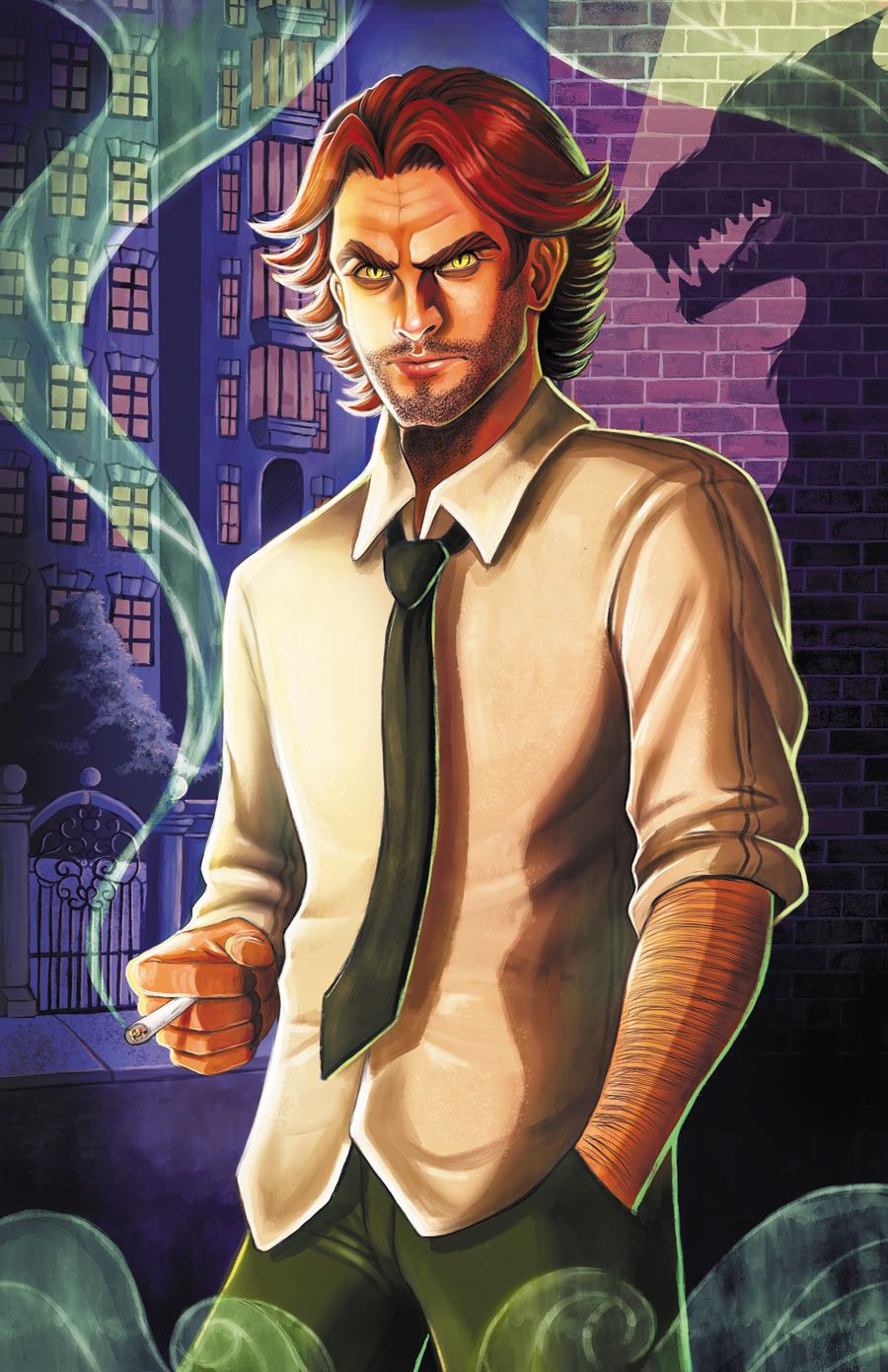Vertigo's first foray into Digital First comics launches today and the DC Comics' imprint has turned to an old friend (and franchise) to give it a big huff and puff in order to blow readers away.
An adaptation and expansion of the popular video game by Telltale Games, "Fables: The Wolf Among Us" is also an official prequel to Bill Willingham's Eisner Award-winning "Fables" comic book series, starring Bigby Wolf at his crime-solving best unlocking the mysteries of a grisly murder.
CBR News connected with co-writers Matt Sturges and Dave Justus to discuss the first chapter -- released digitally today, December 10. The writing team explained that their storyline is closely tied to the events of the video game, but since "Fables: The Wolf Among Us" is a "Choose Your Own Adventure"-style episodic experience, their comic is the canonical account of what happened when Bigby came face-to-face with his old nemesis, the Woodsman.
Sturges is a long-time collaborator of "Fables" creator Bill Willingham, having served as co-writer of "Jack of Fables," the spinoff series starring Jack Horner, while Justus previously worked with Vertigo on its "House of Mystery" anthology special. The Digital First tale, which will be collected in print in the new year, features art by Stephen Sadowski ("JSA"), Shawn McManus ("Fables," "Fairest") and Travis Moore ("JSA All-Stars").
CBR News: Matt, your history with the "Fables" universe is well known and documented but Dave, this is you first foray into this world. What's your knowledge of Bill Willingham's not-so-mundane reality?
Dave Justus: I bought the first issue off the shelf of the incomparable Austin Books & Comics. Willingham had spent a number of his hardscrabble years in Austin, Texas, and was and remains a good friend of the shop, so when the owner suggested I give the book a try, I figured I had nothing to lose. I had a vague notion of Willingham's work from "Elementals," but "Fables" was clearly on another level entirely. I fell for it hard, especially by the time of the "Animal Farm" arc. By 2003 I was working at the shop and hand-selling it to anyone who'd slow down long enough to listen to me.
Matt Sturges: It's entirely likely that I bought issues of "Fables" from Dave before we knew each other, oddly enough.
How did this collaboration come about?
Sturges: Writers often never know how these things actually come about. By the time I got asked to participate in it, it was already a done deal, so I assume it was some kind of shady deal done in a smoke-filled back room. But I get most of my information about how the world works from movies, so that may not be entirely accurate. A more accurate guess might be that The Vertigo Powers That Be were looking for a book that would make a good debut outing for a Digital First comic, and this is a thing that has a potential built-in readership.
The only problem was that, even though I readily agreed to tackle the book -- it's "Fables," how could I say no? -- it was clear that the project was a massive undertaking that I was in no way prepared to handle on my own. It's a 10-page script a week, every week, for a lot of weeks, and I have other jobs, so freelancer panic soon set in and I started complaining about it to my friends...
Justus: During one of our should-be-more-regular chats with novelist and comics writer Daryl Gregory, Matt was despairing that he'd simply taken on too many projects, and that he was afraid "The Wolf Among Us" might have to fall by the wayside. I said, "Hell, I'll do it," in that sort of joking way where I wasn't joking at all. A week later, Matt called my bluff and asked whether I'd be interested in co-writing the book with him. He and I have partnered on a number of projects, and we've developed a solid understanding of each other's weaknesses, mostly his, and strengths, mostly mine. [Laughs]
Has Bill been involved in plotting the series or steering this project?
Justus: Every script has passed before Bill's eyes, and he's been nothing but complimentary. Early on, we peppered him with questions -- things that the game didn't fully answer, or avenues Matt and I wanted to explore, but only with Bill's blessing. And he's always there, of course, if we hit a stumbling block trying to remember exactly how blind a mouse was, or something. But he's been great about letting us play with his toys -- and even break them, as long as we do so in interesting ways.
Sturges: Bill is unbelievably generous with his toys. I guess his parents must have really emphasized sharing, because he is the exact opposite of a tyrant when it comes to doing things with and to his characters. You'd think that, having put in all the effort to create and define them that he'd be a lot more protective of them but he really seems to take a laissez-faire attitude to it -- which is great, until you realize that all the mistakes you make are your own and Bill will share none of the blame for them. But it's a small price to pay for access to so much fun stuff.
Do you have to write or prepare the series any differently than your traditional projects as it is being released digitally?
Sturges: We do. One of the things I've always loved about writing comics is the formalism attached to it: You have a certain number of pages, the page is a certain size, you can only fit so many words in so many places. Those constraints are paradoxically freeing to an artist, because by limiting some avenues of expression, it helps you see what's possible. Altering the dimensions and presentation of the page creates a whole new set of limitations, and thus a whole new set of possibilities. At first, it's daunting when you realize that you have to learn a new set of rules, but then you start to see how you can do things differently, doing things that haven't really been tried before, and that's where it gets really exciting.
Justus: Right. On the screen, you're seeing only half of a traditional printed comics page. The layout needs to work unto itself, and as the top or bottom section of a larger whole as well. Rather than letting that be an impediment, though, we've worked to come up with new ways to play with the layouts. In the third chapter, for example, we're able to have a full-page splash that also works as a last-second reveal. In the sixth chapter, a chase on foot has a different energy depending on whether you're reading it digitally or in print. And the deeper we get into scripting, the more we're discovering the flexibility of the digital format. Fortunately, we've got a hell of an art team to indulge our weird flights of fancy.
The video game is set years before the first issue of "Fables" -- is this digital comic book series set in the same era? And how closely is the story tied to the events of the game?
Sturges: Although we don't nail down precisely when the story takes place, it's not long before the events in the first volume of "Fables." So the burgeoning romance between Bigby and Snow White in those early issues of Willingham's series? It's pre-burgeoning here, I guess. Ante-burgeoning?
Justus: Just to be clear: Our comic is an adaptation of the game, so it's the same basic set of events, the same mystery, but it's told in a somewhat different way, with lots of flourishes and backstory you won't find in the game. Our story starts out very similarly to the game -- the opening vignette was perfect, and we didn't see any reason to tinker with it -- but it very quickly establishes itself as a separate entity by the time you've gotten through a couple of chapters.
And I believe the proper word is "proto-burgeoning."
Justus: Bigby is the POV character, but unlike in the game, he also provides narration for the comic so we get much deeper into his head, his case files, his methodology, and his emotions, even though he's a guy who tries to keep those tamped down.
Every player's experience of the game is different depending on decisions they make and what roads they travel down. We have the job of telling the canon version. These are decisions that Bigby made regardless of what you think.
Ultimately, it's the same overall story, but you can make it take a lot of different forms by the choices that you make.
Sturges: And these decisions come in consultation with Bill Willingham. We asked him, "When you played the game, what choices did you make?" There is a very particular moment in the game that is a favorite of ours when you have a choice whether or not to remove a body part from a particular villain and you know Bill and I, we are both bloodthirsty, it's pretty obvious what choice we made.
What makes Bigby a strong lead for a story? He isn't a traditional Joseph Campbell-style hero.
Sturges: Much gets made of the Campbellian hero, but that's really only one type of narrative. The Hero With a Thousand Faces is a story about personal development and self-actualization, but that's not what every story is about. For a crime story, the protagonist usually has no such journey, but acts more as a fixed point of view and moral focus. In that sense, it could be disastrous if the hero were to be drastically altered by the events of the story because the hero is the ethical yardstick by which we measure everyone else's behavior. In that sense, Bigby is the perfect protagonist because his sense of justice and order is entirely fixed. He can be affected by the events of the story, but we can assume he won't be undone by them. There are exceptions, of course. Dennis Lehane's "Gone, Baby, Gone" is an excellent example of a crime novel whose events call everything the protagonist believes into question.
Justus: There's a great deal of complexity to the character of Bigby. It wasn't enough for Willingham to throw the wolf from that "Three Little Pigs" story into his comic and call it a day. We've learned why he's got such lung power, where his lupine side comes from. We've seen him in war, in love, at play, nurturing and murdering. If it's true that he's not a traditional, Joseph Campbell-style hero, maybe it's because that definition is too narrow to contain him.
Who else is featured in the comics' cast?
Justus: We, and Telltale Games before us, cast a pretty wide net in populating this story, pulling in some A-listers as well as some obscure one-panel wonders. Obviously, Snow White plays a huge role. She and Bigby partner up to solve the murder mystery at the book's core, buddy cops under the irascible acting mayor Ichabod Crane. Bufkin knows where the books are filed and where Crane's wine is hidden. Beauty and Beast are around, keeping up appearances. The Woodsman has an axe to grind. And, of course, since Matt is co-writing, it would've been criminal not to slip his old pal, Jack of Fables, into the mix. You'll see plenty of your old favorites, far too many to list here. And that's just in the first couple of chapters.
Sturges: I feel like we should create a new Fable. Like, why not? I'm sure there's got to be somebody that hasn't been used in Fables yet. There's still time. We have a lot of chapters left to write.
Is this an ongoing or limited series and if it's ongoing, do you have an endgame planned for the series?
Justus: I believe this is what they used to call a "maxi-series," which sounds like the perfect comic for today's active lifestyles. Matt and I broke out our plan for it. And that plan was lengthy. We submitted that plan to editorial with the thought that we'd probably have to prune it back a bit. We were not asked to swallow any prunes at all. The story will have plenty of space to breathe, and while we certainly have an endgame in mind, it's written in very dark pencil, not ink. Stories sometimes have a way of telling themselves.
Sturges: That's right. It's an adaptation and extension of the story from the game. It does follow the same narrative but we take you to a lot of different places and we're providing back stories, side narratives and digressions that you will not find in the game. There is a lot of extra content, even though it is technically an adaption of the story.




